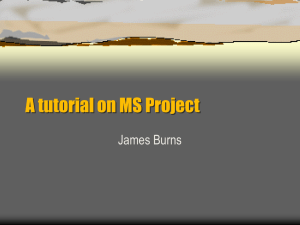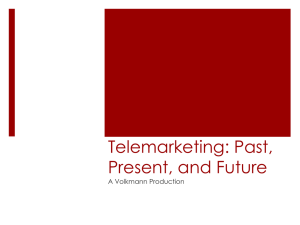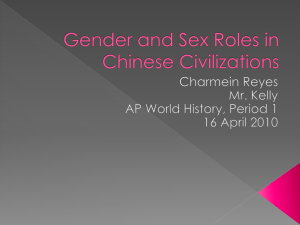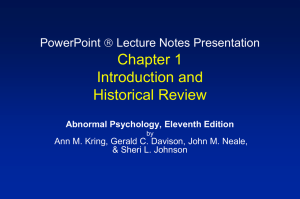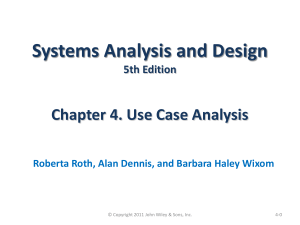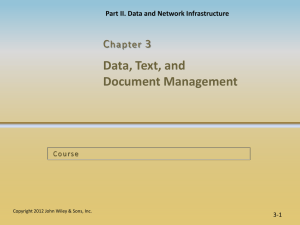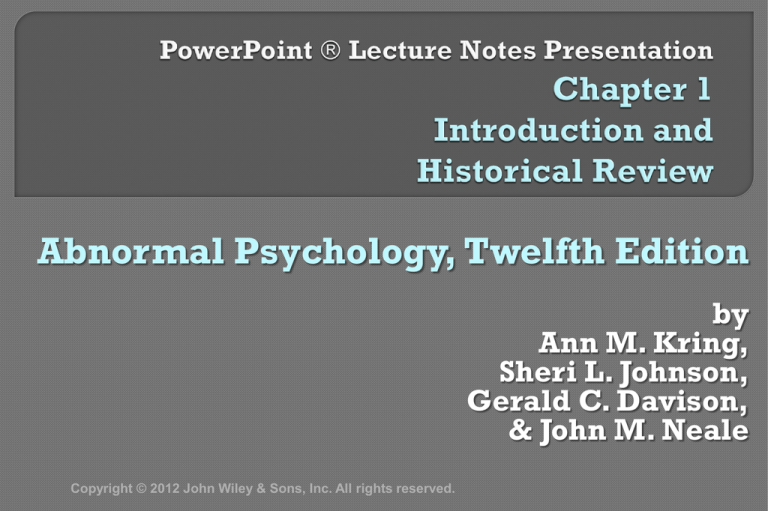
Abnormal Psychology, Twelfth Edition
by
Ann M. Kring,
Sheri L. Johnson,
Gerald C. Davison,
& John M. Neale
Copyright © 2012 John Wiley & Sons, Inc. All rights reserved.
Chapter
1: Introduction and Historical
Review
I. Introduction to the Study of Mental Disorders
II. History of Psychopathology
III. The Evolution of Contemporary Thought
IV. The Mental Health Professions
© 2012 John Wiley & Sons, Inc. All rights reserved.
Study
of the nature, development, and
treatment of psychological disorders
Challenges
to the study of psychopathology:
• Maintain objectivity
• Avoid preconceived notions
• Reduce stigma
© 2012 John Wiley & Sons, Inc. All rights reserved.
© 2012 John Wiley & Sons, Inc. All rights reserved.
Personal
Distress
• Emotional pain and suffering
Helplessness and hopelessness of depression
Disability
• Impairment in a key area (e.g., work, relationships)
Chronic substance abuse results in job loss
Violation
of Social Norms
• Makes others uncomfortable or causes problems
Antisocial behavior of the psychopath
Dysfunction
• Wakefield's Harmful Dysfunction: failure of internal
mechanisms in the mind to function properly
© 2012 John Wiley & Sons, Inc. All rights reserved.
© 2012 John Wiley & Sons, Inc. All rights reserved.
Early Demonology
• Possession by evil beings or spirits
Exorcism
Early Biological Explanations
• Hippocrates (5th century BC)
Mental disturbances have natural (not supernatural)
causes (problems with the brain)
Three categories of mental disorders: mania, melancholia, &
phrenitis (brain fever)
Normal brain functioning depended on balance of four humors:
blood, black bile, yellow bile, & phlegm
© 2012 John Wiley & Sons, Inc. All rights reserved.
Dark Ages (2nd century AD)
• Monks cared and prayed for mentally ill
Witches (13th century AD)
• Torture sometimes led to bizarre delusional
sounding confessions, e.g., concourse with demons.
Initially, historians concluded many of the accused were
mentally ill.
Further research found little support for this conclusion.
© 2012 John Wiley & Sons, Inc. All rights reserved.
Lunacy Trials
• Trials held to determine sanity
Began in 13th century England
• Municipal authorities assumed responsibility for
care of mentally ill
• Lunacy attributes insanity to misalignment of moon
(“luna”) and stars
© 2012 John Wiley & Sons, Inc. All rights reserved.
Asylums
(15th century AD)
• Establishments for the confinement and care of
mentally ill
• Priory of St. Mary of Bethlehem (founded in 1243)
One of the first mental institutions
The wealthy paid to gape at the insane
Origin of the term bedlam (wild uproar or confusion)
• Treatment non-existent or harmful at asylums
Benjamin Rush recommended drawing copious amounts
of blood, to relieve brain pressure
© 2012 John Wiley & Sons, Inc. All rights reserved.
Philippe
Pinel (1745-1826)
• Pioneered humanitarian treatment at LaBicetre
Moral Treatment
• Small, privately funded, humanitarian mental
hospitals
Friends Asylum (1817)
Patients engaged in purposeful, calming activities (e.g.,
gardening)
Talked with attendants
© 2012 John Wiley & Sons, Inc. All rights reserved.
Dorothea
Dix (1802-1887)
• Crusader for prisoners and mentally ill
• Urged improvement of institutions
• Worked to establish 32 new, public hospitals
• Unfortunately, small staffs at these new public
hospitals could not provide necessary individual
attention
• Hospitals administered by physicians, who were
more interested in biological rather than
psychological aspects of mental illness
© 2012 John Wiley & Sons, Inc. All rights reserved.
General
paresis and Syphilis
• Degenerative disorder with psychological symptoms
(delusions of grandeur) and physical symptoms
(progressive paralysis)
• By mid-1800’s, it was known that general paresis and
syphilis occurred together in some patients
• In 1905, biological cause of syphilis found
• Since general paresis had biological cause, other mental
illness might also
Biological causes of psychopathology gained credibility
© 2012 John Wiley & Sons, Inc. All rights reserved.
Galton’s
(1822-1911) work lead to notion that mental
illness can be inherited
• Nature (genetics) and nurture (environment)
• Eugenics
Promotion of enforced sterilization to eliminate undesirable
characteristics from the population
Many state laws required mentally ill to be sterilized
© 2012 John Wiley & Sons, Inc. All rights reserved.
Insulin-coma
therapy
• Sakel (1930’s)
Electroconvulsive Therapy
(ECT)
• Cerletti and Bini (1938)
• Induce epileptic seizures with electric shock
Prefrontal
lobotomy
• Moniz (1935)
• Often used to control violent behaviors; led to
listlessness, apathy, and loss of cognitive abilities
© 2012 John Wiley & Sons, Inc. All rights reserved.
Mesmer (1734-1815)
• Treated patients with hysteria using “animal
magnetism”
• Early practitioner of hypnosis
Charcot (1825-1893)
• His support legitimizes hypnosis as treatment for
hysteria
Breuer (1842-1925)
• Used hypnosis to facilitate catharsis in Anna O.
• Cathartic Method
Release of emotional tension triggered by reliving and talking
about event
© 2012 John Wiley & Sons, Inc. All rights reserved.
Breuer
and Freud (1856-1939) jointly
publish, “Studies in Hysteria” in 1895,
which serves as the basis for Freud’s
theory.
Freudian or Psychoanalytic theory
• Human behavior determined by unconscious
forces.
• Psychopathology results from conflicts among
these unconscious forces.
© 2012 John Wiley & Sons, Inc. All rights reserved.
Id
• Unconscious
• Pleasure principle
Immediate gratification
• Libido
Energy of ID
Ego
• Primarily conscious
• Reality principle
Attempt to satisfy ID’s demands within reality’s constraints
Superego
• The conscience
• Develops as we incorporate parental and society values
© 2012 John Wiley & Sons, Inc. All rights reserved.
Id, Ego, & Superego continually in conflict
• Conflict generates anxiety
• Ego generates strategies to protect itself from anxiety
Defense mechanisms
Psychological maneuvers used to manage stress & anxiety
© 2012 John Wiley & Sons, Inc. All rights reserved.
© 2012 John Wiley & Sons, Inc. All rights reserved.
Goals
of Psychoanalytic Therapy or
Psychoanalysis
• Understand early-childhood experiences,
particularly key (parental) relationships
• Understand patterns in current relationships
Psychoanalytic Techniques
• Free Association
• Analysis of Transference
• Interpretation
© 2012 John Wiley & Sons, Inc. All rights reserved.
© 2012 John Wiley & Sons, Inc. All rights reserved.
Jung
(1875-1961)
• Analytical psychology
• Collective unconscious
Archetypes
• Catalogued personality characteristics
Extraversion vs. Introversion
Adler
(1870-1937)
• Individual psychology
Fulfillment derived from working for the social good
© 2012 John Wiley & Sons, Inc. All rights reserved.
Childhood
experiences help shape adult
personality
There are unconscious influences on
behavior
There are unconscious influences on
behavior
© 2012 John Wiley & Sons, Inc. All rights reserved.
John Watson
(1878-1958)
Behaviorism
• Focus on observable behavior
• Emphasis on learning rather than thinking or
innate tendencies
Three
types of learning:
• Classical Conditioning
• Operant Conditioning
• Modeling
© 2012 John Wiley & Sons, Inc. All rights reserved.
Discovered
by Pavlov (1849-1936)
• Unconditioned Stimulus (UCS)
•
•
•
•
•
Meat powder (automatically elicits salivation)
Unconditioned Response (UR)
Salivation (automatic response to meat powder)
Neutral Stimulus (NS)
Initial ringing of bell (does not automatically elicit salivation)
Conditioned Stimulus (CS)
After pairing the NS and the UCS, the NS becomes a CS (bell
now automatically elicits salivation)
Conditioned Response (CR)
Salivation (automatic response to bell)
Extinction
CS (bell) not followed by UCS (meat powder) causes gradual
disappearance of CR (salivation)
© 2012 John Wiley & Sons, Inc. All rights reserved.
© 2012 John Wiley & Sons, Inc. All rights reserved.
E. Thorndike (1874-1949)
• Learning through consequences
• Law of Effect
Behavior that is followed by satisfying consequences will be repeated;
behavior that is followed by unpleasant consequences will be
discouraged
B.F. Skinner (1904-1990)
• Principle of Reinforcement
Positive reinforcement
Behaviors followed by pleasant stimuli are strengthened
Negative reinforcement
Behaviors that terminate a negative stimulus are strengthened
© 2012 John Wiley & Sons, Inc. All rights reserved.
Learning
by watching and imitating others’
behaviors
• Can occur without reinforcement
Bandura
& Menlove (1968)
• Modeling reduced children’s fear of dogs
© 2012 John Wiley & Sons, Inc. All rights reserved.
Behavior Therapy
or Behavior Modification
• Systematic Desensitization
Used to treat phobias and anxiety
Combines deep muscle relaxation and gradual
exposure to the feared condition or object
Starts with minimal anxiety producing condition and
gradually progresses to most feared
• Intermittent Reinforcement
Rewarding a behavior only occasionally more effective
than continuous schedules of reinforcement
© 2012 John Wiley & Sons, Inc. All rights reserved.
Limitations
of Behavior Therapy
• How we think or appraise a situation influences our
feelings and behaviors
Cognitive Therapy
• Emphasize how people think about themselves and
their experiences can be a major determinant of
psychopathology
• Focus on understanding maladaptive thoughts
• Change cognitions to change feelings and behaviors
Ellis
(1913-2007)
• REBT (Rational-Emotive Behavior Therapy)
© 2012 John Wiley & Sons, Inc. All rights reserved.
Psychologists
• Clinical or Counseling
• Ph. D. or Psy. D.
Psychiatrists
• M.D.’s can prescribe psychotropic medications
Psychiatric Nurses and Psychiatric Nurses Practitioners
• Nurse Practitioners can prescribe psychotropic medications
Social Workers
• M.S.W.
• Not trained in psychological assessment
Master’s Level Therapists & Counselors
• MFT’s (Marriage and Family Therapists)
© 2012 John Wiley & Sons, Inc. All rights reserved.
Copyright 2012 by John Wiley & Sons, New York,
NY. All rights reserved. No part of the material
protected by this copyright may be reproduced or
utilized in any form or by any means, electronic
or mechanical, including photocopying,
recording or by any information storage and
retrieval system, without written permission of
the copyright owner.
© 2012 John Wiley & Sons, Inc. All rights reserved.





